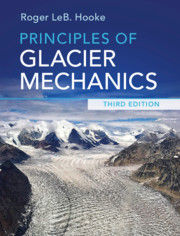Book contents
- Principles of Glacier Mechanics
- Reviews
- Principles of Glacier Mechanics
- Copyright page
- Dedication
- Contents
- Preface to the third edition
- Preface to the second edition
- Preface to the first edition
- Physical constants relevant to ice
- Derived SI units and conversion factors
- 1 Why study glaciers?
- 2 Some basic concepts
- 3 Mass balance
- 4 Flow and fracture of a crystalline material
- 5 The velocity field in a glacier
- 6 Temperature distribution in polar ice sheets
- 7 The coupling between a glacier and its bed
- 8 Water flow in and under glaciers: Geomorphic implications
- 9 Stress and deformation
- 10 Stress and velocity distribution in an idealized glacier
- 11 Numerical modeling
- 12 Applications of stress and deformation principles to classical problems
- 13 Ice streams and ice shelves
- 14 Finite strain and the origin of foliation
- 15 Response of glaciers to climate change
- 16 Ice core studies
- Problems
- References
- Index
14 - Finite strain and the origin of foliation
Published online by Cambridge University Press: 20 December 2019
- Principles of Glacier Mechanics
- Reviews
- Principles of Glacier Mechanics
- Copyright page
- Dedication
- Contents
- Preface to the third edition
- Preface to the second edition
- Preface to the first edition
- Physical constants relevant to ice
- Derived SI units and conversion factors
- 1 Why study glaciers?
- 2 Some basic concepts
- 3 Mass balance
- 4 Flow and fracture of a crystalline material
- 5 The velocity field in a glacier
- 6 Temperature distribution in polar ice sheets
- 7 The coupling between a glacier and its bed
- 8 Water flow in and under glaciers: Geomorphic implications
- 9 Stress and deformation
- 10 Stress and velocity distribution in an idealized glacier
- 11 Numerical modeling
- 12 Applications of stress and deformation principles to classical problems
- 13 Ice streams and ice shelves
- 14 Finite strain and the origin of foliation
- 15 Response of glaciers to climate change
- 16 Ice core studies
- Problems
- References
- Index
Summary
As an initially cubic element of ice is advected through a glacier, it is gradually deformed. By the time it melts out at the glacier margin, it may be hundreds of times longer and fractions of a percent as thick as when it started. The deformation of such an element is described by three parameters, the natural octahedral unit shear, the angle through which a material line that becomes a principal axis in the strained state has rotated, and the angle that the greatest principal axis makes with the x-axis.Once primary features such as snow stratigraphy and crevasse fillings are deformed by this cumulative strain, their origin is difficult or impossible to determine, and the resulting penetrative layering is properly called foliation.Foliation is most highly developed where shear strain rates are highest - along the bed and adjacent to valley walls. Once formed, foliation may become deformed by changes in flow regime. An advance or retreat of a glacier can lead to recumbent folds in basal ice, and surges can result in sweeping folds in foliation defined by medial moraines. Foliation planes in ice sheet margins are not shear planes.
- Type
- Chapter
- Information
- Principles of Glacier Mechanics , pp. 387 - 407Publisher: Cambridge University PressPrint publication year: 2019

